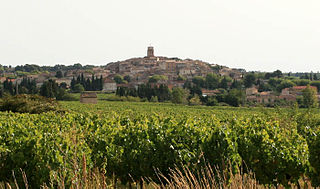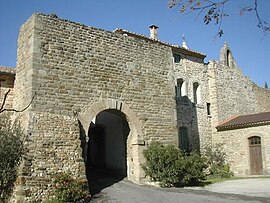
The Rhône wine region in Southern France is situated in the Rhône valley and produces numerous wines under various Appellation d'origine contrôlée (AOC) designations. The region's major appellation in production volume is Côtes du Rhône AOC.

Mourvèdre is a red wine grape variety grown in many regions around the world including the Rhône and Provence regions of France, the Valencia and Jumilla and Yecla denominaciones de origen (DOs) of Spain, as well as the Balearic Islands, California and Washington and the Australian regions of South Australia and New South Wales, plus South Africa. In addition to making red varietal wines, Mourvèdre is a prominent component in "GSM" blends. The variety is also used to make rosé and port-style fortified wines.

Côte-Rôtie is a French wine Appellation d'origine contrôlée (AOC) in the northern Rhône wine region of France. The vineyards are located just south of Vienne in the communes of Saint-Cyr-sur-le-Rhône, Ampuis, and Tupin-et-Semons. The vineyards are unique because of the steep slopes facing the river and their stone walls. Côte-Rôtie can be rendered in English as "the roasted slope" and refers to the long hours of sunlight that these steep slopes receive.
Lirac is a wine-growing Appellation d'Origine Contrôlée (AOC) in the department of Gard situated in the low hills along the right bank of the Rhône river in the southern Rhône wine region of France. It is named after the village of Lirac. Bordering on the neighbouring cru of Tavel AOC, a rosé-only cru in the next village, Lirac is one of the 13 crus of the Rhône valley family. Châteauneuf-du-Pape AOC is across the Rhône from it.

Vacqueyras is a French wine Appellation d'Origine Contrôlée (AOC) in the southern Rhône wine region of France, along the banks of the River Ouvèze. It is primarily a red wine region with some white and rosé wines being produced. Being a little brother of Châteauneuf-du-Pape and, arguably, Gigondas, the wine is moderately prestigious and can yield pleasing results when treated correctly.

Rasteau is an Appellation d'Origine Contrôlée for wine in the southern Rhône wine region of France, covering both fortified and unfortified wines. The sweet fortified wines can be red, rosé or white, and have long been produced under the Rasteau AOC. In 2010 dry red wines (unfortified) were also added to the appellation, effective from the 2009 vintage.

Côtes du Rhône is a wine-growing Appellation d'Origine Contrôlée (AOC) for the Rhône wine region of France, which may be used throughout the region, also in those areas which are covered by other AOCs. In a limited part of the region, the Côtes-du-Rhône Villages AOC may be used, in some cases together with the name of the commune.

Roquemaure is a small town and commune in the Gard department of southern France. The town lies 12 kilometres north of Avignon on the right bank of the Rhône. In 2017 the commune had a population of 5,481.

Bourboulenc is a white wine grape variety primarily grown in southern France. The variety is found in the regions Southern Rhône, Provence and Languedoc.

French wine is produced all throughout France, in quantities between 50 and 60 million hectolitres per year, or 7–8 billion bottles. France is one of the largest wine producers in the world, along with Italian, Spanish, and American wine-producing regions. French wine traces its history to the 6th century BCE, with many of France's regions dating their wine-making history to Roman times. The wines produced range from expensive wines sold internationally to modest wines usually only seen within France such as the Margnat wines of the post war period.

Languedoc-Roussillon wine, including the vin de pays labeled Vin de Pays d'Oc, is produced in southern France. While "Languedoc" can refer to a specific historic region of France and Northern Catalonia, usage since the 20th century has primarily referred to the northern part of the Languedoc-Roussillon region of France, an area which spans the Mediterranean coastline from the French border with Spain to the region of Provence. The area has around 700,000 acres (2,800 km2) under vines and is the single biggest wine-producing region in the world, being responsible for more than a third of France's total wine production. In 2001, the region produced more wine than the United States.

The Tricastin is a natural and historic region in the southern Rhône valley of southeastern France comprising the southwestern portion of the Drôme department and the northwestern portion of Vaucluse and centered on the modern town of Saint-Paul-Trois-Châteaux.

Saint-Roman-de-Malegarde is a commune in the Vaucluse department in the Provence-Alpes-Côte d'Azur region in southeastern France.

Sablet is a commune in the Vaucluse department in the Provence-Alpes-Côte d'Azur region in southeastern France.

Laudun-l'Ardoise is a commune in the Gard department in the Occitania region in Southern France. It is located on the departmental border with Vaucluse, which is also the regional border with Provence-Alpes-Côte d'Azur. In 2019, it had a population of 6,331.
Côtes du Marmandais is an Appellation d'origine contrôlée (AOC) for wine located in South West France around the commune of Marmande. With its location just southeast of the Entre-Deux-Mers along the banks of the Garonne river, it is a satellite of Bordeaux, but just outside the borders of that region. The region was elevated from Vin Délimité de Qualité Superieure (VDQS) to AOC status in 1990. From the Middle Ages to the 19th century, the wines of the Côtes du Marmandais were widely exported to the Netherlands. The Phylloxera epidemic wiped out most of the vineyards in this area with many farmers switching to other agricultural crops. It was not until the later half of the 20th century that viticulture in the area reaffirmed itself.

Provence (Provençal) wine comes from the French wine-producing region of Provence in southeast France. The Romans called the area provincia nostra, giving the region its name. Just south of the Alps, it was the first Roman province outside Italy.

Beaumes de Venise is an appellation of wines from the eastern central region of the southern half of the Rhône Valley. It produces wines of two distinctly different types:

Vinsobres is an Appellation d'Origine Contrôlée (AOC) for red wine in the southern part of the Rhône wine region of France, situated around Vinsobres.

Cairanne AOC is a wine-growing AOC in the southern Rhône wine region of France, in the commune of Cairanne in the Vaucluse département. Red and white wines are produced. Previously a part of Côtes-du-Rhône Villages AOC, the wines received their own AOC provisionally on 20 June 2016, and definitely on 25 June 2018.
























